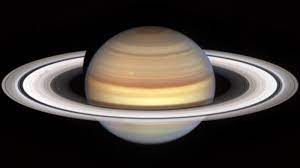If you can get your hands on a telescope, there are few sights more spectacular than the magnificent ringed planet – Saturn. Currently, Saturn is clearly visible in the evening sky, at its highest just after sunset. It’s the ideal time to use a telescope or binoculars to get a good view of the Solar System’s sixth planet and its famous rings.
But in the past few days, a slew of articles have run like wildfire through social media. Saturn’s rings, those articles claim, are rapidly disappearing – and will be gone by 2025!
So what’s the story? Could the next couple of months, before Saturn drops out of view in the evening sky, really be our last chance to see its mighty rings? The short answer is no. While it’s true the rings will become almost invisible from Earth in 2025, this is neither a surprise nor reason to panic. The rings will “reappear” soon thereafter. Here’s why.
Tipping and tilting Earth
To understand why our view of Saturn changes, let’s begin by considering Earth on its constant journey around the Sun. That journey takes us through the seasons – from winter to spring, summer and autumn, then back again. What causes the seasons? Put simply, Earth is tilted towards one side, as seen from the Sun. Our equator is tilted by about 23.5 degrees from the plane of our orbit.
The result? As we move around the Sun, we alternately tip one hemisphere and then the other towards our star. When your home hemisphere is tilted more towards the Sun, you get longer days than nights and experience spring and summer. When you’re tilted away, you get shorter days and longer nights, and experience autumn and winter.
Saturn, a giant tilted world
Just like Earth, Saturn experiences seasons, but more than 29 times longer than ours. Where Earth’s equator is tilted by 23.5 degrees, Saturn’s equator has a 26.7 degree tilt. The result? As Saturn moves through its 29.4-year orbit around our star, it also appears to nod up and down as seen from both Earth and the Sun. What about Saturn’s rings? The planet’s enormous ring system, comprised of bits of ice, dust and rocks, spreads out over a huge distance – just over 280,000km from the planet. But it’s very thin – in most places, just tens of metres thick. The rings orbit directly above Saturn’s equator and so they too are tilted to the plane of Saturn’s orbit.
So why do Saturn’s rings ‘disappear’?
The rings are so thin that, seen from a distance, they appear to vanish when edge on. You can visualise this easily by grabbing a sheet of paper, and rotating it until it is edge on – the paper almost vanishes from view.
As Saturn moves around the Sun, our viewpoint changes. For half of the orbit, its northern hemisphere is tilted towards us and the northern face of the planet’s rings is tipped our way. The best way to illustrate this is to get your sheet of paper, and hold it horizontally – parallel to the ground – at eye level.























